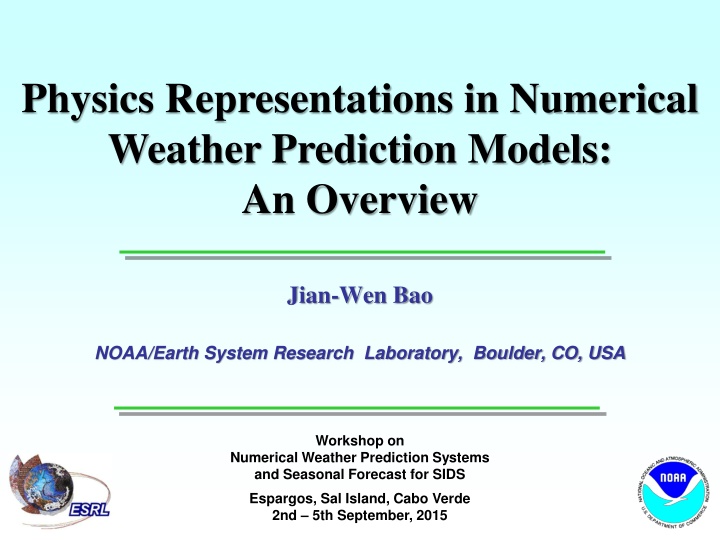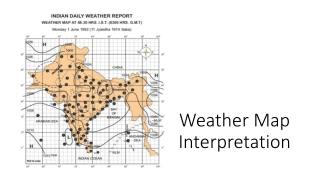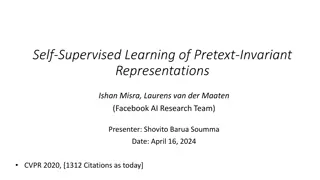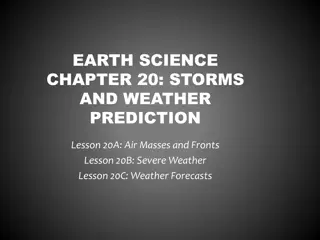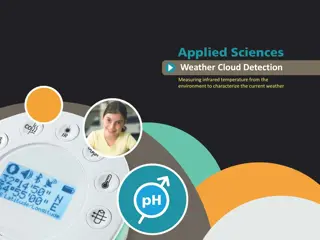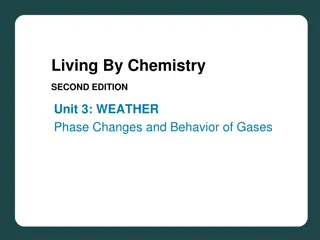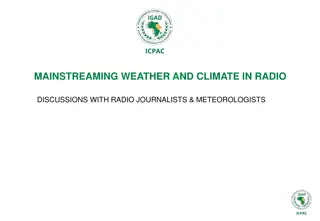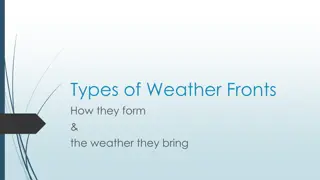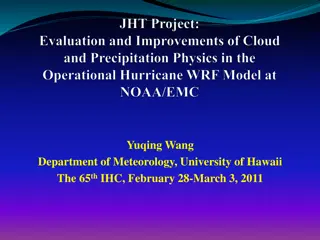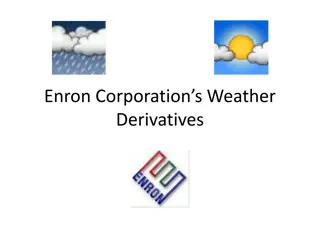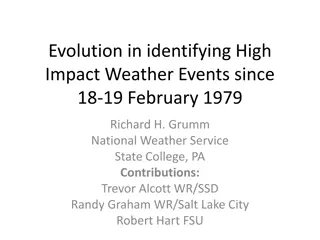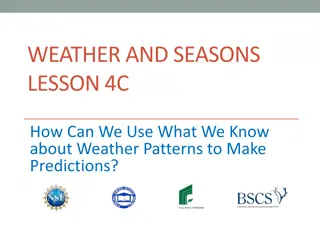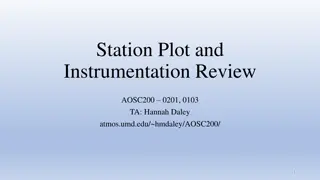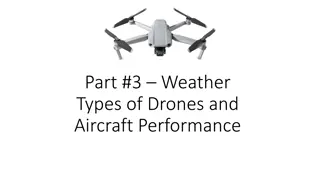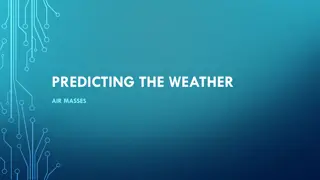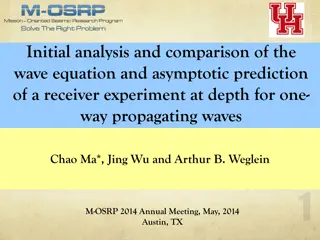Overview of Physics Representations in Weather Prediction Models
An overview of physics representations in numerical weather prediction models, including parameterization of diabatic forcing, clouds, radiation transfer, sub-grid mixing, and surface property transfer.
Uploaded on Mar 12, 2025 | 1 Views
Download Presentation

Please find below an Image/Link to download the presentation.
The content on the website is provided AS IS for your information and personal use only. It may not be sold, licensed, or shared on other websites without obtaining consent from the author.If you encounter any issues during the download, it is possible that the publisher has removed the file from their server.
You are allowed to download the files provided on this website for personal or commercial use, subject to the condition that they are used lawfully. All files are the property of their respective owners.
The content on the website is provided AS IS for your information and personal use only. It may not be sold, licensed, or shared on other websites without obtaining consent from the author.
E N D
Presentation Transcript
Physics Representations in Numerical Weather Prediction Models: An Overview Jian-Wen Bao NOAA/Earth System Research Laboratory, Boulder, CO, USA Workshop on Numerical Weather Prediction Systems and Seasonal Forecast for SIDS Espargos, Sal Island, Cabo Verde 2nd 5th September, 2015
Outline Introduction Representing diabatic forcing through physics parameterizations Parameterization of clouds Grid resolved processes: microphysics of clouds and precipitation Sub-grid processes: clouds and precipitation associated with unresolved moist convection Parameterization of radiation transfer Basic concepts and approximations Parameterization of sub-grid mixing Mixing by turbulence and surface fluxes Parameterization of surface property transfer Basic components: air-sea/land interface fluxes, oceanic PBL mixing and oceanic surface waves
Introduction: representations of physics in numerical weather prediction (NWP) models In all the operational NWP models, the following physics processes are required to be represented through parameterizations: Microphysics of resolved clouds and precipitation Radiation (short-wave and long-wave) Subgrid turbulence mixing and diffusion (including planetary boundary layer and surface layer) Subgrid convection Interaction with Earth s surface
Introduction: What is parameterization and why is it needed This diagram depicts some of the physical processes and parameters that are typically parameterized, both because they cannot be explicitly predicted in full detail in model forecast equations regardless of the grid point or wave number resolution and because their effects on the forecast variables resolvable by a model are crucial to forecast realism.
Introduction: Why parameterize (contd) The effects that model physics parameterizations attempt to simulate are generally unresolvable at grid scales and can be categorized as follows: Shortwave (solar) and longwave (terrestrial) radiation in the atmosphere; this includes the effects of clouds, water vapor, trace gases, and aerosols. Land and sea surface characteristics and their impact on how incoming radiation affects surface energy and water balances; this includes the effects of vegetation type, soil type, soil moisture quantities, snow, water bodies, and land and sea ice.
Introduction: Why parameterize (contd) Convective processes: Important vertical redistribution of heat and moisture by convection can easily occur between mesoscale grid boxes. The animation shows the development of the rain shaft (white and gray) and the accompanying cold pool (blue shading). Notice that sub grid-scale variations in the convection will have an effect on the moisture and heating in some of the model grid boxes.
Introduction: Why parameterize (contd) Microphysical processes: Even in very high-resolution models, microphysical processes occur on a scale too small to be modeled explicitly. There are important variations in both the horizontal and vertical. In this example, the cloud microphysical processes of condensation and droplet growth are occurring inside a 1-km model grid box.
Introduction: Why parameterize (contd) A model cannot resolve any of these local flows, swirls, or obstacles if they exist within a grid box. However, the model must account for the aggregate effect of these surfaces on the low-level flow with a single number that goes into the friction (F) term in the forecast wind equation. The method of accounting for such effects without directly forecasting them is called parameterization. NWP models cannot resolve weather features and/or processes that occur within a single model grid box. This is just a simple example. In the real atmosphere, there are many complex processes that need to be parameterized. This example shows complex flow around a variety of surface features: Friction that is large over tall trees Turbulent eddies created around buildings or other obstacles Much less surface friction over open areas
Introduction: Why parameterize (summary) The standard Reynolds decomposition and averaging lead to co-variances that need closure or parameterization . Radiation absorbed, scattered and emitted by molecules, aerosols and cloud droplets play an important role in the atmosphere and need parameterization . Cloud microphysical processes need parameterization . Parameterization schemes express the effect of sub-grid processes in resolved variables such as U, V, T, and q(v, l, ...)
Reynolds decomposition Take the equation for potential temperature as an example: 2 2 2 + + + = + + + ( ) u v w Q 2 2 2 t x y x x y z advection source molecular diffusion + = w W = + , ' w , ' U u u V v v Reynolds decomposition: = + = + , ' '. Averaged over a grid box (and a time step): + + + = u v w t x y x + + + ' + + ' + ( ' ' ) ( ' ) ( ' ) Q u v w x x y y z z : source term (e.g. radiation absorpt./emiss. or condens.) ' w : subgrid (Reynolds) transport term (e.g. due to turbulence, convection) Q '
Importance of and requirements for physics parameterizations in NWP models (summary) Importance: Tendencies from diabatic processes are substantial and contribute to the evolution of the atmosphere even in the short range. Diabatic processes drive the general circulation and synoptic development. The parameterized physics provide important daily weather parameters: diurnal cycle, clouds, precipitation, fog, surface wind and gusts, T and q at 2m level. Requirements: Accommodate different applications. Parameterization needs to work over a wide range of spatial resolutions. Time steps are long (from a few seconds to a few minutes); Numerics needs to be efficient and robust. Interactions between processes are important and should be considered in the design of the schemes.
Parameterization of resolved clouds: Which quantities to represent ? Water vapor Cloud water droplets Rain drops Pristine ice crystals Aggregate snow flakes Graupel pellets Hailstones Note for ice phase particles: Additional latent heat. Terminal fall speed of ice hydrometeors significantly less. Optical properties are different (important for radiation).
Cloud microphysical processes We would like to include in NWP models: Formation of clouds Release of precipitation Evaporation of both clouds and precipitation Therefore we need to describe Nucleation of water droplets and ice crystals from water vapor Diffusional growth of cloud droplets (condensation) and ice crystals (deposition) Collection processes for cloud drops (collision-coalescence), ice crystals (aggregation) and ice and liquid (riming) leading to precipitation sized particles The advection and sedimentation (falling) of particles the evaporation/sublimation/melting of cloud and precipitation size particles
Cloud parameterization Issues: Degree of complexity ? Complexity Small ice Ice Mass Ice mass Cloud Mass Medium ice Liquid Mass Ice number Large ice Single Moment Schemes Double Moment Schemes Spectral/Bin Microphysics Most NWP models only have simple single-moment schemes
Cumulus convection is ubiquitous in the tropics and latent heat transport in cumulus convection is the primary method of transferring energy from the surface to the atmosphere. Therefore, cumulus convection needs to be represented in numerical models of tropical weather. Cumulus convection occurs at several scales, which means that it is impossible for the model to resolved and predict all individual clouds. Therefore, numerical models create parameters to account for the effect of cumulus convection within individual grid boxes. (Above) Photograph of tropical cumulus, (Right) processes to be accounted for in subgrid parameterization schemes. Tropical Convective Processes: How NWP models emulate?
Elements of convection parameterization Determine occurrence/location of convection Trigger Determine vertical distribution of heating, moistening and momentum changes Cloud model Determine the overall amount of the energy conversion, convective precipitation = heat release Closure
Shortwave and Longwave Radiation Processes We know the amount of incoming solar energy at the top of the atmosphere at diurnal, synoptic, and short-range climate timescales. But uncertainties arise in emulating the effects of the atmosphere and earth's surface on incoming solar and outgoing terrestrial radiation.
Uncertainties in shortwave and longwave radiation processes includes In the atmosphere Transmission/Absorption Reemission (for atmospheric longwave radiation) Reflection Scattering At the earth's surface Transformation from shortwave into other forms of energy at the earth's surface, based on the state of that surface over the area covered by the model grid box Net emission of longwave radiation from the earth's surface toward space
Uncertainties in shortwave and longwave radiation processes (cont d) These uncertainties exist because: We can only crudely emulate the effects of the atmosphere and its constituents (for example, clouds, aerosols, and absorbing gases) on the incoming solar beam and outgoing terrestrial/longwave radiation; We can only estimate the state of the land and sea surface in models and its effects on the absorption and subsequent conversion of incoming shortwave radiation into other forms of energy. The real world data needed to fine-tune the emulation of land and sea surface physics (for example, soil moisture and surface fluxes) are incomplete.
The basics of radation transfer parameterization The Radiative Transfer Equation (RTE) For NWP model applications, no polarization effect stationarity (no explicit dependence on time) plane-parallel (no sphericity effect) Sources and sinks: Extinction Emission Scattering
Parameterization of the PBL Mixing (Overview) Parameterization Application Order and Type of Closure 0th order non-local Bulk models Models that treat PBL top as surface K-profile Models with fair resolution 1st order local or non-local Models with high resolution TKE-closure 1.5th order local Higher order closure Models with high resolution 2nd or 3rd order local
Property Summary of the K-Profile and TKE Schemes 1. The K-profile scheme assumes that there is a well defined layer h in which the vertical distribution of diffusivities follows a special cubic polynomial function x(1-x)2, where x = z/h. 2. The TKE scheme naturally links the PBL depth to the sub-grid TKE distribution, though it does require a specification of the mixing length. 3. The magnitude of the diffusivities from the K-profile scheme is determined by the PBL depth, while in the TKE scheme it is determined by the mixing length.
Parameterization of surface fluxes Surface layer (Monin Obukhov) similarity Ocean surface fluxes Roughness lengths and transfer coefficients Air-sea coupling at high wind speeds
What is in the land surface physics? Vegetation effects included Predicts soil temperature and soil moisture in four layers and diagnoses skin temperature Predicts snow cover and canopy moisture Handles fractional snow cover and frozen soil Time-varying snow albedo Provides heat and moisture fluxes for PBL Urban Canopy Model options
Atmospheric BL-Wave-Current Interaction Processes Atmospheric Boundary Layer Sea state, Sea spray Atmosphere air Current air Surface waves Ocean c Current air c Ocean currents Courtesy of Isaac Ginis
Wind-Wave-Current Interaction Courtesy of Fabrice Veron
